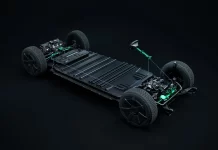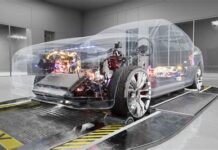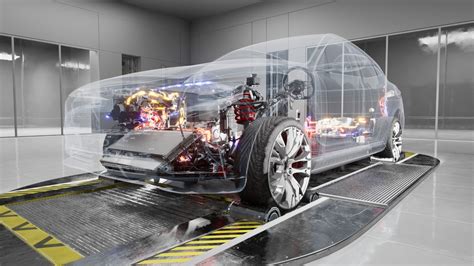As electric vehicles (EVs) continue to reshape the automotive landscape, understanding the intricacies of their operation is essential. While EVs promise a cleaner, more efficient way to travel, they are not immune to errors and misconceptions that can lead to frustration among drivers. This article aims to demystify common electrical vehicle errors by exploring the myths and facts surrounding their performance, maintenance, and battery management systems. We will address how proper charging habits and software functionalities impact overall vehicle reliability, while also equipping you with a practical troubleshooting guide. By recognizing the signs of common errors and understanding their causes, you’ll be better prepared to enjoy the full range of benefits that electric vehicles offer. Join us as we delve into the fascinating world of electric vehicles and clarify some of the most prevalent myths that can cloud your driving experience.
Understanding Common Electric Vehicle Errors And Their Causes
As electric vehicles (EVs) continue to gain traction in the automotive market, understanding the common electric vehicle errors that drivers might encounter is crucial. These issues can stem from various sources, including technical glitches, user habits, and infrastructural limitations. Below, we will explore some of the most frequent errors and their underlying causes.
| Error Type | Possible Causes |
|---|---|
| Battery Drain | Poor charging habits, extreme temperatures, and old battery age. |
| Charging Issues | Incompatible charging station, faulty charging cables, or software bugs. |
| Navigation Errors | Outdated maps, software issues, or GPS signal loss. |
| Regenerative Braking Malfunction | Faulty sensors, software updates needed, or physical brake issues. |
Understanding these factors can greatly enhance the ownership experience and help EV users identify problems quickly. By being aware of the common electric vehicle errors and their causes, drivers can take proactive steps to mitigate issues and improve their vehicle’s performance.
Debunking Myths About Electric Vehicle Performance Issues
Despite the growing popularity of electric vehicles (EVs), several misconceptions continue to surround their performance. Understanding these myths is crucial for potential and current EV owners, as they can influence purchasing decisions, maintenance practices, and overall satisfaction. Here, we will debunk some common myths related to electric vehicle performance issues.
1. Myth: Electric Vehicles Are Slow and Have Poor Acceleration.
Many people assume that electric vehicles cannot compete with traditional combustion engines in terms of speed. In reality, most electric vehicles, thanks to their electric motors, can accelerate much faster than their gas counterparts. For instance, models like the Tesla Model S can go from 0 to 60 mph in under 2 seconds, demonstrating impressive performance.
2. Myth: Electric Vehicles Can’t Handle Long Distances.
Another widespread belief is that common electric vehicle errors stem from range limitations. However, advancements in battery technology and charging infrastructure mean that many new EVs can cover substantial distances on a single charge, often exceeding 300 miles. Additionally, the expansion of fast-charging stations has made long-distance travel increasingly feasible.
3. Myth: Extreme Weather Conditions Significantly Reduce EV Performance.
While it is true that extreme temperatures can affect battery efficiency, electric vehicles are designed to adapt to various conditions. Most EVs come equipped with thermal management systems to help maintain optimal battery temperature, ensuring reliable performance in both hot and cold climates.
4. Myth: Charging Electric Vehicles Takes Too Much Time.
Some potential buyers worry about the time needed to charge an EV compared to refueling a gas vehicle. While it is true that charging an EV can take longer, advancements in charging technologies, like DC fast chargers, can provide an 80% charge in approximately 30 minutes. Planning for charging during breaks or overnight can effectively integrate charging into daily routines.
5. Myth: Electric Vehicles Require Complicated Maintenance.
A prevalent misconception is that electric vehicles involve complex maintenance routines. In fact, EVs have fewer moving parts than traditional vehicles, leading to lower maintenance requirements overall. The absence of oil changes, fuel filters, spark plugs, and exhaust systems typically means owners can save on routine maintenance costs.
By debunking these myths, potential owners can better understand the actual performance of electric vehicles and the common electric vehicle errors that might arise. Awareness and education can pave the way for more informed decisions, ultimately leading to greater satisfaction with electric vehicle ownership.
Recognizing Signs Of Common Electric Vehicle Errors
Identifying common electric vehicle errors early can save EV owners from costly repairs and ensure a smoother driving experience. Here are some key signs to look out for that could indicate an underlying issue with your electric vehicle:
- Battery Warning Lights: If the dashboard displays any battery warning indicators, it is crucial to address this immediately. These lights can signify issues with charging or battery health.
- Unusual Sounds: Electric vehicles are generally quieter than traditional vehicles, so any sudden noises such as grinding, whirring, or clicking could indicate mechanical or electrical problems.
- Reduced Range: If you notice a significant drop in the driving range between charges, this could suggest that the battery is not performing optimally or that there’s an issue with the energy management system.
- Charging Problems: Difficulty in charging or inconsistent charging speeds can be a sign of a faulty charging port or issues within the battery management system.
- Overheating: An increase in temperature during operation can indicate problems with the battery cooling system or other components of the EV.
- Performance Fluctuations: A sudden lack of acceleration or inconsistent performance while driving might signal a software issue or a problem with the vehicle’s electronic control unit.
Being vigilant about these signs can aid in early detection of common electric vehicle errors. Regular check-ups and monitoring your EV’s performance are essential to keep your vehicle running efficiently and safely.
How Proper Maintenance Can Prevent Electric Vehicle Errors
Proper maintenance is crucial for minimizing common electric vehicle errors and ensuring optimal performance throughout the vehicle’s lifespan. Just like traditional vehicles, electric vehicles (EVs) require regular upkeep to mitigate potential issues and enhance their reliability. Here are some key maintenance practices to consider:
- Regular Software Updates: EV manufacturers frequently release software updates that improve functionality, performance, and security. Keeping your vehicle’s software up-to-date can prevent numerous performance-related issues.
- Battery Health Checks: Monitoring the battery health is essential, as the battery is at the heart of the electric vehicle’s performance. Routine checks can help identify any degradation or imbalance in the battery cells.
- Tire Maintenance: Proper tire inflation and regular rotation can greatly affect energy efficiency and driving safety. Underinflated tires can lead to abnormal wear and decreased range, which can be mistaken as common electric vehicle errors.
- Cooling System Maintenance: Electric vehicles rely on effective thermal management systems to maintain optimal battery temperatures. Regular checks of coolant levels and system integrity can prevent overheating and related issues.
- Brake System Inspection: Although EVs use regenerative braking, it’s essential to inspect braking systems regularly. Worn brake pads can affect performance and may create concerns that mimic other common electric vehicle errors.
By following these maintenance tips, EV owners can significantly reduce the incidence of common electric vehicle errors and enhance their overall driving experience. Regular servicing not only extends the life of the vehicle but also helps in identifying potential issues before they develop into more significant problems.
The Impact Of Charging Habits On Electric Vehicle Errors
Charging habits play a crucial role in the performance and longevity of electric vehicles (EVs). Adopting improper charging practices can lead to a range of common electric vehicle errors, affecting everything from battery health to overall vehicle efficiency.
One significant error arises from frequent use of fast chargers. While fast charging is convenient, relying on it too often can generate excess heat that may accelerate battery degradation. It’s important to balance fast charging with regular use of standard charging stations, which help maintain battery health.
Another aspect to consider is the state of charge (SOC), as consistently charging an EV to 100% can also contribute to battery wear over time. Many experts suggest keeping the SOC between 20% and 80% for daily use, which can significantly improve battery lifespan and mitigate some common electric vehicle errors related to battery performance.
Additionally, leaving an EV plugged in for extended periods can lead to issues like trickle charging, where the vehicle’s system may continuously cycle between charging and discharging. This cycle can cause wear on battery cells and lead to common electric vehicle errors that could require troubleshooting.
Moreover, extreme temperatures can complicate charging habits. High or low ambient temperatures can affect charging efficiency and battery management systems. It’s advisable to monitor charging conditions during extreme weather to minimize exposure to these common electric vehicle errors.
In essence, adopting mindful charging habits is vital for preventing common electric vehicle errors. By practicing proper charging techniques and being aware of environmental factors, EV owners can enjoy a smoother driving experience and prolong the life of their vehicles.
Common Errors In Electric Vehicle Battery Management Systems
The battery management system (BMS) plays a crucial role in ensuring the performance and longevity of electric vehicle (EV) batteries. However, several common electric vehicle errors can arise within these systems. Understanding these errors and their implications can help users maintain optimal vehicle performance.
- Inaccurate State of Charge (SoC) Readings: One of the most prevalent errors in a BMS is the incorrect estimation of the battery’s state of charge. This can lead to unexpected shut-downs or limited range perception by the driver.
- Cell Balancing Issues: Effective BMS should balance the charge across individual cells to maximize battery life. If the system fails to perform this task, some cells may become overcharged, leading to diminished overall battery performance.
- Temperature Management Failures: BMS also monitors temperature to prevent overheating. Errors in this monitoring can cause thermal runaway situations or reduced charging efficiency during colder conditions.
- Voltage Monitoring Errors: Inaccurate voltage readings can jeopardize battery health. If the BMS does not detect a cell functioning outside its nominal voltage, it could result in battery damage.
- Firmware Bugs: Software-related issues can lead to various malfunctions within the battery management system. Regular software updates can mitigate these risks.
Addressing these common electric vehicle errors in battery management systems is essential for ensuring the safety, efficiency, and longevity of electric vehicles. Manufacturers and users alike should remain vigilant to enhance their EV experience and avoid expensive mitigations down the line.
Exploring Software-Related Errors In Electric Vehicles
As electric vehicles (EVs) become increasingly sophisticated, their reliance on complex software systems grows. This software controls everything from battery management to driving dynamics and user interfaces. However, with this complexity comes the possibility of common electric vehicle errors that can arise from software-related issues.
One of the most prevalent software-related errors in EVs involves glitches in the vehicle’s firmware. These glitches can cause erratic behaviors such as sudden loss of power, incorrect battery percentage displays, or failure to initiate charging. Regular software updates are essential to fix these bugs and to ensure optimal performance.
Another common issue stems from compatibility problems between the vehicle’s software and various charging stations. If the software does not recognize a charging station, the vehicle may fail to charge or experience slower charging rates. Such errors can lead to user frustration and potential range anxiety.
Additionally, data communication errors can occur between different vehicle systems. For instance, the communication between the battery management system and the power control module may falter, leading to inefficient power usage or premature battery depletion. Regular diagnostics can help detect and rectify these communication breakdowns before they escalate into significant issues.
Understanding the implications of software-related errors is crucial for both manufacturers and users. With advancements in machine learning and artificial intelligence, future vehicles are likely to become more adaptive, learning from driver behaviors and environmental conditions. However, this also means that thorough testing and validation of software will be paramount to minimize the risks associated with common electric vehicle errors.
Myths And Facts About Electric Vehicle Range Anxiety
One of the most prevalent concerns surrounding electric vehicles (EVs) is range anxiety, which refers to the fear of running out of battery before reaching a destination. This anxiety is not baseless, but it is often exacerbated by myths that misrepresent the reality of electric vehicle capabilities.
- Myth 1: Electric vehicles cannot travel long distances.
- Myth 2: Charging an electric vehicle takes too long.
- Fact: Most EV drivers charge at home.
- Fact: Range drops in extreme weather.
This myth has gradually been dispelled as advancements in battery technology have increased the range of many electric vehicle models. Today, numerous EVs can comfortably travel over 200 to 300 miles on a single charge, making long trips feasible.
While charging an EV does take longer than refueling a gasoline car, many drivers can charge their vehicles overnight at home. Additionally, public fast-charging stations can recharge EV batteries to 80% in about 30 minutes, which is increasingly convenient for road trips.
The majority of electric vehicle owners charge their vehicles overnight, creating an efficient refueling routine that typically eliminates range anxiety on a day-to-day basis.
It is a fact that range can diminish in extreme temperatures. Cold weather can reduce battery efficiency and thus the distance an electric vehicle can travel before needing a charge. However, this is also a concern for combustion vehicles, which can face fuel efficiency challenges in bad weather.
By understanding the nuances behind common electric vehicle errors related to range anxiety, drivers can make informed decisions and develop a healthy relationship with their EVs. Education about myths and facts ensures that potential electric vehicle owners can move forward with confidence, knowing they have the right information to guide their purchasing and usage decisions.
Troubleshooting Guide For Common Electric Vehicle Errors
Troubleshooting common electric vehicle errors can be a straightforward process if you follow a systematic approach. Here’s a guide to help you identify and rectify issues effectively:
- Check the Dashboard Alerts: Start by looking for any warning lights or error messages displayed on the dashboard. These indicators can provide critical insights into what might be malfunctioning.
- Inspect the Battery Level: Sometimes, issues arise simply due to a low battery charge. Ensure that your vehicle is adequately charged and confirm that the charging cable is functioning properly.
- Review the Owner’s Manual: Each electric vehicle model may have specific troubleshooting steps. Refer to the owner’s manual for detailed information about potential issues and their solutions.
- Examine the Charging Equipment: If you encounter problems while charging, inspect the charging station and cable. Look for any signs of wear or damage, and make sure the connections are secure.
- Reset Software or Systems: Sometimes, a simple software reset can resolve minor glitches. Follow the manufacturer’s instructions to perform a system reset, if applicable.
- Test Drive for Performance Issues: Conduct a short test drive to assess any performance-related problems, such as unusual noises or braking issues. This can help you pinpoint specific errors.
- Seek Professional Diagnostics: If basic troubleshooting doesn’t resolve the issue, consider taking your electric vehicle to a certified technician. Professional diagnostic tools can uncover deeper system errors.
- Participate in Online Forums: Electric vehicle owners often share their experiences in forums. Engaging in these communities can provide insights into similar problems and potential solutions.
Remember, early detection and intervention can prevent minor issues from escalating into major repairs, ensuring your electric vehicle operates efficiently. Familiarizing yourself with how to troubleshoot common electric vehicle errors can enhance your driving experience and prolong the life of your EV.
Future Trends To Minimize Common Electric Vehicle Errors
As the electric vehicle (EV) market continues to evolve, several promising trends are emerging that aim to significantly reduce common electric vehicle errors. These advancements not only aim to enhance the overall reliability of electric vehicles but also ensure a smoother user experience.
One notable trend is the integration of artificial intelligence (AI) and machine learning in vehicle systems. AI can analyze driving habits and environmental conditions in real-time, allowing for proactive maintenance alerts and troubleshooting suggestions, thus preventing issues before they develop into more serious errors.
Another key development is the advancement of battery technology. New battery chemistries and designs are being created to enhance performance and lifespan, which will ultimately minimize the number of common electric vehicle errors related to battery management systems. Solid-state batteries, for instance, promise improved safety, energy density, and quicker charging times, reducing the likelihood of charging-related errors.
Moreover, the implementation of over-the-air (OTA) software updates is revolutionizing how electric vehicles manage software-related issues. These updates allow manufacturers to deploy fixes and improvements directly to vehicles, addressing bugs or performance issues without the need for physical service appointments. This connectivity not only enhances vehicle functionality but also contributes to minimizing common electric vehicle errors.
Enhanced driver education and support systems are being established. As automakers and dealerships invest more in consumer education, electric vehicle owners will be better informed about their vehicles, the importance of maintenance, and how to effectively manage their charging habits, leading to a decrease in user-induced errors.
The future of electric vehicles holds great promise in effectively reducing common electric vehicle errors through technology, innovation, and enhanced user engagement.
Frequently Asked Questions
What are some common myths about electric vehicles (EVs)?
Some common myths include that EVs have limited range, take too long to charge, and are not suitable for cold weather.
Do electric vehicles require more maintenance than traditional combustion engine vehicles?
No, electric vehicles generally require less maintenance due to fewer moving parts, as they don’t need oil changes and have simpler drivetrains.
Can electric vehicles be charged at home easily?
Yes, most electric vehicle owners charge their cars at home using a standard outlet or a dedicated home charging station.
Are electric vehicles environmentally friendly?
While EVs produce zero tailpipe emissions, their overall environmental impact depends on how the electricity is generated, but they typically result in lower greenhouse gas emissions compared to traditional vehicles.
Is it true that electric vehicles are more expensive than gasoline cars?
Initially, some electric vehicles may have a higher purchase price, but this can be offset by lower fuel costs and maintenance expenses over time.
Do electric vehicles have performance limitations compared to gas vehicles?
Not necessarily; many electric vehicles offer impressive acceleration and torque, outperforming some traditional vehicles in speed and responsiveness.
What should I consider before purchasing an electric vehicle?
Consider factors like your daily driving range, access to charging infrastructure, initial costs, and available incentives or rebates for EV purchases.














Testaru. Best known
By the end of the 15th century, 35